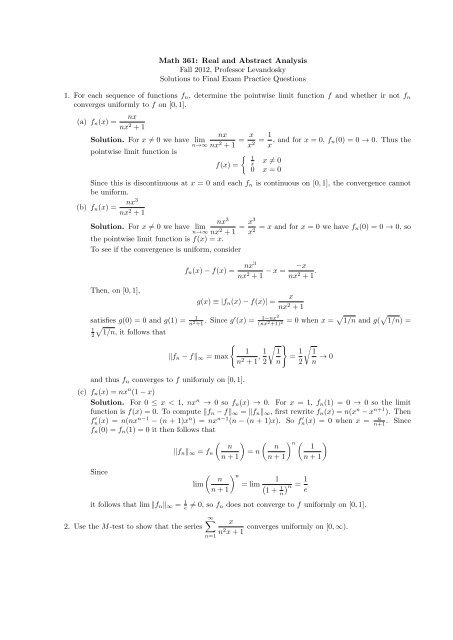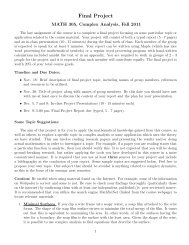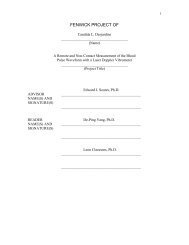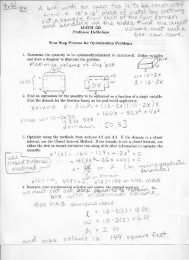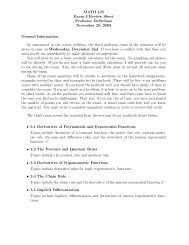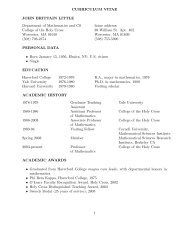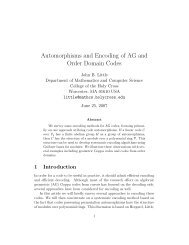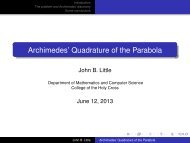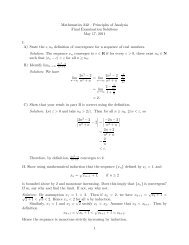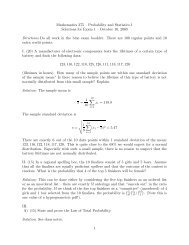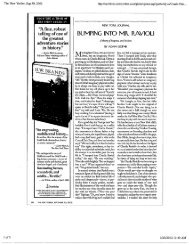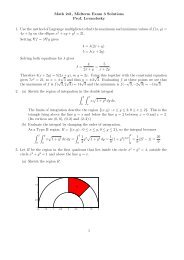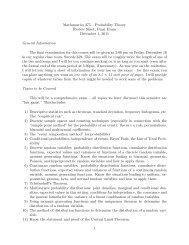Solutions to Final Exam Practice Questions
Solutions to Final Exam Practice Questions
Solutions to Final Exam Practice Questions
You also want an ePaper? Increase the reach of your titles
YUMPU automatically turns print PDFs into web optimized ePapers that Google loves.
Math 361: Real and Abstract Analysis<br />
Fall 2012, Professor Levandosky<br />
<strong>Solutions</strong> <strong>to</strong> <strong>Final</strong> <strong>Exam</strong> <strong>Practice</strong> <strong>Questions</strong><br />
1. For each sequence of functions fn, determine the pointwise limit function f and whether ir not fn<br />
converges uniformly <strong>to</strong> f on [0, 1].<br />
(a) fn(x) = nx<br />
nx 2 + 1<br />
Solution. For x ̸= 0 we have lim<br />
n→∞<br />
pointwise limit function is<br />
nx<br />
nx 2 + 1<br />
f(x) =<br />
x 1<br />
= =<br />
x2 x , and for x = 0, fn(0) = 0 → 0. Thus the<br />
{<br />
1<br />
x<br />
x ̸= 0<br />
0 x = 0<br />
Since this is discontinuous at x = 0 and each fn is continuous on [0, 1], the convergence cannot<br />
be uniform.<br />
(b) fn(x) = nx3<br />
nx 2 + 1<br />
nx<br />
Solution. For x ̸= 0 we have lim<br />
n→∞<br />
3<br />
nx2 + 1<br />
the pointwise limit function is f(x) = x.<br />
To see if the convergence is uniform, consider<br />
Then, on [0, 1],<br />
= x3<br />
x 2 = x and for x = 0 we have fn(0) = 0 → 0, so<br />
fn(x) − f(x) = nx3<br />
nx2 −x<br />
− x =<br />
+ 1 nx2 + 1 .<br />
g(x) ≡ |fn(x) − f(x)| =<br />
satisfies g(0) = 0 and g(1) = 1<br />
n2 +1 . Since g′ (x) = 1−nx2<br />
√<br />
1/n, it follows that<br />
1<br />
2<br />
∥fn − f∥∞ = max<br />
and thus fn converges <strong>to</strong> f uniformly on [0, 1].<br />
x<br />
nx 2 + 1<br />
(nx 2 +1) 2 = 0 when x = √ 1/n and g( √ 1/n) =<br />
{<br />
1<br />
n2 √ }<br />
1 1<br />
, =<br />
+ 1 2 n<br />
1<br />
√<br />
1<br />
→ 0<br />
2 n<br />
(c) fn(x) = nx n (1 − x)<br />
Solution. For 0 ≤ x < 1, nxn → 0 so fn(x) → 0. For x = 1, fn(1) = 0 → 0 so the limit<br />
function is f(x) = 0. To compute ∥fn − f∥∞ = ∥fn∥∞, first rewrite fn(x) = n(xn − xn+1 ). Then<br />
f ′ n(x) = n(nxn−1 − (n + 1)xn ) = nxn−1 (n − (n + 1)x). So f ′ n(x) = 0 when x = n<br />
n+1 . Since<br />
fn(0) = fn(1) = 0 it then follows that<br />
( ) ( ) n ( )<br />
n<br />
n 1<br />
∥fn∥∞ = fn = n<br />
n + 1 n + 1 n + 1<br />
Since<br />
( ) n<br />
n<br />
lim<br />
= lim<br />
n + 1<br />
1<br />
( 1 + 1<br />
n<br />
) n = 1<br />
e<br />
it follows that lim ∥fn∥∞ = 1<br />
e ̸= 0, so fn does not converge <strong>to</strong> f uniformly on [0, 1].<br />
2. Use the M-test <strong>to</strong> show that the series<br />
∞∑<br />
n=1<br />
x<br />
n 2 x + 1<br />
converges uniformly on [0, ∞).
Solution. Let gn(x) = x<br />
n2x+1 . Then g′ n(x) = 1<br />
lim<br />
x→∞ gn(x) = 1<br />
n2 it follows that Mn = ∥gn∥∞ = 1<br />
n2 . Since the series<br />
∞∑<br />
gn(x) converges uniformly on [0, ∞).<br />
n=1<br />
3. Consider the series<br />
∞∑<br />
k=1<br />
x<br />
k 2 x 2 + 1 .<br />
(n 2 x+1) 2 > 0 for all x ∈ [0∞). Since gn(0) = 0 and<br />
(a) Show that for each x ∈ R, the series converges.<br />
Solution. For x = 0, the series clearly converges (<strong>to</strong> 0). For x ̸= 0, we have<br />
<br />
<br />
<br />
x<br />
k<br />
2x2 <br />
<br />
<br />
|x|<br />
+ 1<br />
≤<br />
k2 1<br />
=<br />
x2 |x|k2 and since the series<br />
converges, the series<br />
∞∑<br />
k=1<br />
x<br />
k 2 x 2 + 1<br />
∞∑<br />
k=1<br />
1 1<br />
=<br />
|x|k2 |x|<br />
∞∑<br />
k=1<br />
1<br />
k 2<br />
∞∑<br />
n=1<br />
converges (absolutely) by the comparison test.<br />
1<br />
converges, the series<br />
n2 (b) Let f(x) be the sum of the series. Prove that the series does not converge uniformly <strong>to</strong> f on R.<br />
Hint: Show that f(1/n) ≥ 1<br />
2 for all n.<br />
Solution. For each n, we have<br />
f(1/n) =<br />
∞∑<br />
k=1<br />
Now when 1 ≤ k ≤ n, 1 ≤ k 2 /n 2 + 1 ≤ 2, so<br />
n∑<br />
k=1<br />
1/n<br />
k 2 /n 2 + 1 ≥<br />
1/n<br />
k 2 /n 2 +1<br />
1/n<br />
k 2 /n 2 + 1 ≥<br />
n∑<br />
k=1<br />
n∑<br />
k=1<br />
1/n<br />
k 2 /n 2 + 1<br />
1/n<br />
≥ 2 . Therefore<br />
1 1<br />
=<br />
2n 2 .<br />
Thus we have the sequence xn = 1<br />
n → 0 with f(xn) ≥ 1<br />
2 for all n, so that f(xn) ̸→ 0 = f(0), and<br />
therefore f cannot be continuous at x = 0. Since each partial sum of the series<br />
continuous, the convergence cannot be uniform.<br />
4. Let A = {f ∈ C([0, 2]) : |f(x)| ≤ 4 for all x ∈ [0, 2]}.<br />
∞∑<br />
k=1<br />
x<br />
k 2 x 2 + 1 is<br />
(a) Show that A is closed and bounded.<br />
Solution. A is the closed ball of radius 4 centered at the zero function, and is therefore closed.<br />
It is bounded since ∥f∥∞ ≤ 4 for each f ∈ A.<br />
(b) Is A compact?<br />
Solution. No, A is not compact. The sequence fn(x) = (x/2) n in A converges pointwise <strong>to</strong> the<br />
discontinuous function f defined by f(x) = 0 for 0 ≤ x < 2 and f(2) = 1. Any subsequence (fnk )<br />
of (fn) also converges pointwise <strong>to</strong> f and since each fnk is continuous, the convergence cannot be<br />
uniform. Hence fnk does not converge uniformly <strong>to</strong> any element of A. Hence A is not compact.<br />
(c) Is A complete?<br />
Solution. Yes, A is complete because it is a closed subset of the complete metric space C([0, 2]).
5. Let Aϵ = {f ∈ C([−ϵ, ϵ]) : |f(x)| ≤ 4} and define<br />
T (f)(x) = 1 +<br />
(a) Find ϵ > 0 such that T : Aϵ → Aϵ.<br />
Solution. Given f ∈ Aϵ, let g = T (f). Then<br />
g(x) = 1 +<br />
∫ x<br />
0<br />
∫ x<br />
0<br />
(f(t)) 2 cos(t) dt.<br />
(f(t)) 2 cos(t) dt.<br />
By the Fundamental Theorem of Calculus, since f is continuous, g is differentiable, and therefore<br />
continuous on [−ϵ, ϵ]. We need <strong>to</strong> show that |g(x)| ≤ 4 for all x ∈ [−ϵ, ϵ] for some ϵ > 0. To that<br />
end, for 0 ≤ x ≤ ϵ we have<br />
∫<br />
x<br />
|g(x)| ≤ 1 + <br />
(f(t)) 2 ∫<br />
<br />
x<br />
cos(t) dt<br />
≤ 1 + (f(t)) 2 ∫ x<br />
| cos(t)| dt ≤ 1 + 16 dt = 1 + 16x ≤ 1 + 16ϵ<br />
0<br />
0<br />
Likewise |g(x)| ≤ 1 + 16ϵ when −ϵ ≤ x ≤ 0. Thus |g(x)| ≤ 4 for all x ∈ [−ϵ, ϵ] provided ϵ ≤ 3<br />
16 .<br />
(b) Find ϵ > 0 such that T is a contraction mapping on Aϵ.<br />
Solution. We need <strong>to</strong> show ∥T (f)−T (g)∥∞ ≤ α∥f −g∥∞ for all f, g ∈ Aϵ for some α < 1. When<br />
0 ≤ x ≤ ϵ,<br />
∫<br />
x<br />
|T (f)(x) − T (g)(x)| = <br />
[f(t) 2 − g(t) 2 <br />
<br />
] cos(t) dt<br />
<br />
≤<br />
0<br />
∫ x<br />
0<br />
≤ ∥f − g∥∞<br />
|f(t) + g(t)||f(t) − g(t)| dt<br />
∫ x<br />
0<br />
= 8x∥f − g∥∞<br />
≤ 8ϵ∥f − g∥∞.<br />
The same inequality holds for −ϵ ≤ x ≤ 0, so ∥T (f) − T (g)∥∞ ≤ 8ϵ∥f − g∥∞ and therefore T is<br />
a contraction mapping provided ϵ < 1<br />
8 .<br />
(c) Show that T has a unique fixed point in Aϵ for the ϵ from part (b).<br />
Solution. The space Aϵ is complete since it is a closed subset of the complete space C([−ϵ, ϵ]).<br />
Therefore, since T is a contraction mapping on Aϵ, the contraction mapping principle implies that<br />
T has a unique fixed point in Aϵ.<br />
(d) Find the fixed point.<br />
Solution. The fixed point f must satisfy T (f) = f and thus<br />
1 +<br />
∫ x<br />
0<br />
8 dt<br />
(f(t)) 2 cos(t) dt = f(x).<br />
Taking the derivative of both sides gives f ′ (x) = f(x) 2 cos(x). This separable differential equation<br />
has solution f(x) =<br />
−1<br />
sin(x)+C<br />
implies C = −1, so f(x) = −1<br />
sin(x)−1<br />
6. According <strong>to</strong> Maple,<br />
∫ π<br />
1<br />
π −π<br />
. The initial condition f(0) = 1 (from the integral equation above)<br />
is the unique fixed point of T .<br />
(e x + e −x ) cos(kx) dx = 2(eπ − e−π )(−1) k<br />
π(1 + k2 .<br />
)<br />
0
(a) Let f(x) = e x + e −x . Use the equation above <strong>to</strong> write the Fourier series for f.<br />
Solution. The integral above gives a formula for ak. Since f is an even function bk = 0 for all k.<br />
Thus the Fourier series for f is<br />
eπ − e−π ∞∑ 2(e<br />
+<br />
π<br />
π − e−π )(−1) k<br />
π(1 + k2 cos(kx)<br />
)<br />
k=1<br />
(b) Does the Fourier series for f converge uniformly <strong>to</strong> f?<br />
Solution. Yes, f is differentiable on [−π, π] and since f is even, its 2π-periodic extension is<br />
continuous, so the Fourier series converges uniformly <strong>to</strong> f on [−π, π].<br />
(c) Evaluate the series at x = 0 and at x = π and use this <strong>to</strong> determine the sum of the series<br />
∞∑<br />
k=1<br />
(−1) k<br />
k 2 + 1 and<br />
∞∑<br />
k=1<br />
1<br />
k 2 + 1 .<br />
Solution. At x = 0 we have<br />
2 = f(0) = eπ − e−π ∞∑ 2(e<br />
+<br />
π<br />
π − e−π )(−1) k<br />
π(1 + k2 )<br />
so<br />
∞∑<br />
k=1<br />
At x = π, since cos(kπ) = (−1) k , we have<br />
so<br />
(−1) k<br />
=<br />
1 + k2 k=1<br />
e π + e −π = f(π) = eπ − e −π<br />
∞∑<br />
k=1<br />
π<br />
eπ 1<br />
−<br />
− e−π 2 .<br />
π<br />
+<br />
∞∑<br />
k=1<br />
1<br />
1 + k2 = π(eπ + e−π )<br />
2(eπ − e−π 1<br />
−<br />
) 2 .<br />
(d) Use Parseval’s equation <strong>to</strong> find the sum of the series<br />
Solution. The square of the L 2 -norm of f is<br />
∥f∥ 2 2 =<br />
∞∑<br />
k=1<br />
2(e π − e −π )<br />
π(1 + k 2 )<br />
1<br />
(k2 .<br />
+ 1) 2<br />
∫ π<br />
(e<br />
−π<br />
x + e −x ) 2 dx = e 2π + 4π − e −2π .<br />
By Parseval’s equation, this is equal <strong>to</strong><br />
(<br />
a<br />
π<br />
2 0<br />
2 +<br />
∞∑<br />
a 2 )<br />
k = π · 4(eπ − e−π ) 2<br />
π2 k=1<br />
Solving for the summation gives<br />
∞∑<br />
k=1<br />
(<br />
1<br />
2 +<br />
∞∑<br />
k=1<br />
1<br />
(1 + k2 ) 2 = π(e2π + 4π − e−2π )<br />
4(eπ − e−π ) 2 − 1<br />
2 .<br />
1<br />
(1 + k2 ) 2<br />
)<br />
.<br />
7. Determine whether or not the Fourier series for each function converges uniformly. You don’t need <strong>to</strong><br />
compute any Fourier coefficients <strong>to</strong> answer this question.<br />
(a) f(x) = x cos(x)<br />
Solution. The 2π-periodic extension of f is discontinuous, so the Fourier series cannot converge<br />
uniformly.<br />
(b) g(x) = ex2<br />
x 4 + 1<br />
Solution. The 2π-periodic extension of g is continuous, and g is differentiable on (−π, π) so the<br />
Fourier series for g converges uniformly <strong>to</strong> g.


